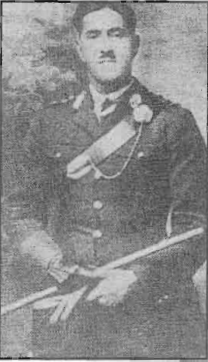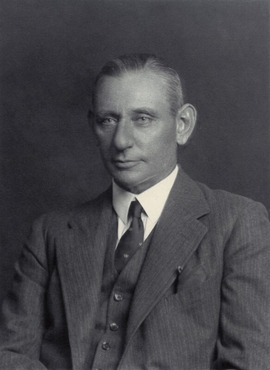
The Special Air Service Regiment, officially abbreviated SASR though commonly known as the SAS, is a special forces unit of the Australian Army. Formed in 1957 as a company, it was modelled on the British SAS with which it shares the motto, "Who Dares Wins". Expanded to a regiment in August 1964, it is based at Campbell Barracks, in Swanbourne, a suburb of Perth, Western Australia, and is a direct command unit of the Special Operations Command.

The 1941 Iraqi coup d'état, also called the Rashid Ali Al-Gaylani coup or the Golden Square coup, was a nationalist coup d'état in Iraq on 1 April 1941 that overthrew the pro-British regime of Regent 'Abd al-Ilah and his Prime Minister Nuri al-Said and installed Rashid Ali al-Gaylani as Prime Minister.

No. 84 Squadron of the Royal Air Force is at present a Search and Rescue Squadron based at RAF Akrotiri, using the Westland/Airbus Helicopters Puma HC Mk.2 helicopter. The squadron transitioned from the previously operated Bell Griffin HAR.2 to the Puma HC.2 in 2023.

The Anglo-Iraqi War was a British-led Allied military campaign during the Second World War against the Kingdom of Iraq under Rashid Gaylani, who had seized power in the 1941 Iraqi coup d'état with assistance from Germany and Italy. The campaign resulted in the downfall of Gaylani's government, the re-occupation of Iraq by the British, and the return to power of the Regent of Iraq, Prince 'Abd al-Ilah, a British ally.

The Syria–Lebanon campaign, also known as Operation Exporter, was the invasion of Syria and Lebanon in June and July 1941 by British Empire forces, during the Second World War.

Royal Air Force Habbaniya, more commonly known as RAF Habbaniya, , was a Royal Air Force station at Habbaniyah, about 55 miles (89 km) west of Baghdad in modern-day Iraq, on the banks of the Euphrates near Lake Habbaniyah. It was developed from 1934, and was operational from October 1936 until 31 May 1959 when the RAF finally withdrew after the July 1958 Revolution made the British military presence no longer welcome. It was the scene of fierce fighting in May 1941 when it was besieged by the Iraqi Military following the 1941 Iraqi coup d'état.
The history of the British Army's Special Air Service (SAS) regiment of the British Army begins with its formation during the Western Desert Campaign of the Second World War, and continues to the present day. It includes its early operations in North Africa, the Greek Islands, and the Invasion of Italy. The Special Air Service then returned to the United Kingdom and was formed into a brigade with two British, two French and one Belgian regiment, and went on to conduct operations in France, Italy again, the Low Countries and finally into Germany.
Iraqforce was a British and Commonwealth formation that came together in the Kingdom of Iraq. The formation fought in the Middle East during World War II.
The Vichy French Air Force, usually referred to as the Air Force of Vichy or Armistice Air Force for clarity, was the aerial branch of the Armistice Army of Vichy France established in the aftermath of the Fall of France in June 1940. The Vichy French Air Force existed between December 1940 and December 1942 and largely served to defend Vichy French territories abroad.

Flyer Command Iraq was a unit of the German Air Force (Luftwaffe) dispatched to Iraq in May 1941 as part of a German mission to support the regime of Rashid Ali during the Anglo-Iraqi War. The mission was part of a larger effort to gain support in the Middle East for the Axis Powers against the United Kingdom and its allies during the World War II.
The Number 2 Armoured Car Company RAF was a military unit of the British Royal Air Force (RAF) which was based at Amman in what was then called the Transjordan. It was the counterpart of No.1 Armoured Car Company RAF, which performed a similar role in Iraq.

Royal Air Force Hinaidi or more commonly known as RAF Hinaidi, is a former Royal Air Force station near Baghdad in the Kingdom of Iraq. It was operational from 1922 until 1937, when operations were transferred to RAF Habbaniya.
Habforce was a British Army military unit created in 1941 during the Anglo-Iraqi War and still active during the Syria-Lebanon campaign during the fighting in the Middle East in the Second World War.

Sir Kinahan Cornwallis was a British administrator and diplomat best known for being an advisor to King Faisal I of Iraq and for being the British Ambassador to the Kingdom of Iraq during the Anglo-Iraqi War.
Sidi Haneish Airfield is an abandoned World War II military airfield complex in Egypt, in the western desert, about 376 km west-northwest of Cairo.

H-2 Air Base is a former Iraqi Air Force base in the Al-Anbar Governorate of Iraq. It was captured by U.S.-led Coalition forces during Operation Iraqi Freedom in 2003.

H-3 Air Base is part of a cluster of former Iraqi Air Force bases in the Al-Anbar Governorate of Iraq. H3 is located in a remote stretch of Iraq's western desert, about 435 kilometers from Baghdad in western Iraq. It is close to the Syrian–Iraqi border, and near the highway that connects Jordan with Baghdad.

Air force ground forces and special forces are the land warfare forces of an air force. They may include infantry, special forces, security forces, and military police. Airmen assigned to such units may be trained, armed and equipped for ground combat and special operations.

The Raid on Sidi Haneish Airfield was a military operation carried out the night of 26 July 1942. A British Special Air Service unit commanded by Major David Stirling attacked a German-held airfield in Egypt during the Western Desert Campaign of Second World War. Several Luftwaffe aircraft used to ferry supplies to the Axis forces were destroyed or damaged with machine-gun fire and explosives. Axis front line units were diverted to reinforce the garrisons in the rear vulnerable to attack.














